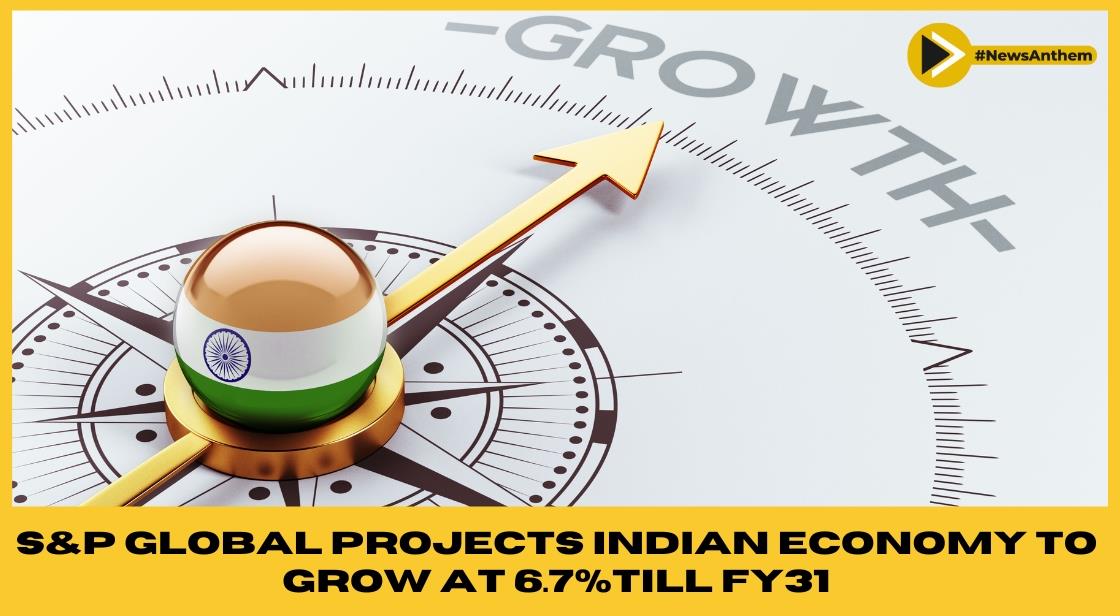Indian Economy Aims for Steady Growth: S&P Global Projects 6.7% Average Annual Growth till FY31

News Synopsis
S&P Global has unveiled a positive outlook for the Indian economy, projecting an average annual growth rate of 6.7% from FY24 to FY31.
"Capital accumulation will be the main driver of Indian growth. The government has substantially stimulated investment by supporting infrastructure projects and incentivising manufacturing," the report states.
India's GDP is projected to nearly double to $6.7 trillion by FY31, while per capita GDP is expected to reach around $4,500, indicating an improvement in living standards for citizens.
However, achieving sustainable growth requires a shift towards high-value-added services and structural reforms to boost private investment and enhance competitiveness.
Indian Economy Set for Impressive Growth
S&P Global's report presents a positive outlook for the Indian economy, forecasting an average annual growth of 6.7% from FY24 to FY31. The report attributes this growth to capital accumulation, which is facilitated by the government's support for infrastructure projects and manufacturing incentives.
"The government has substantially stimulated investment by supporting infrastructure projects and incentivising manufacturing," the report states. India's GDP is projected to nearly double to $6.7 trillion by FY31, reflecting significant economic expansion.
Per capita GDP is also expected to rise to approximately $4,500, reflecting an improved standard of living.
Emphasis on Manufacturing and High-Value-Added Services
Chief Economic Advisor, V Anantha Nageswaran, underscores the importance of the manufacturing sector and the need to shift towards high-value-added services. "The Indian economy, in real terms, needs to grow annually at 7-7.5 per cent until 2030. The share of manufacturing in total gross value added must rise from 16 per cent at present to at least 25 per cent of GDP, displacing agriculture and low-value-added services," said Nageswaran. Moreover, services should pivot towards high-value-added segments, attracting foreign demand and enhancing earnings.
Challenges and Necessary Reforms
The report highlights potential challenges for India's sustained growth, including harnessing the demographic dividend and increasing labor force participation through skill development.
Structural reforms in land, logistics, and labor are deemed essential to stimulate private investment and enhance competitiveness, driven by foreign direct investment. "India's short-term economic growth will be underpinned by its 678.6 million strong labour force," the report concluded, while urging measures to encourage more women to participate in the workforce, as the current rate stands at only 24%.
Some relevant and latest facts for the above news:
-
In 2022-23, India's GDP grew by 7.2%, making it the fastest-growing major economy in the world.
-
The Indian government has announced a number of investment plans in recent years, including the National Infrastructure Pipeline (NIP) and the Production-Linked Incentive (PLI) scheme.
-
The NIP aims to invest $1.5 trillion in infrastructure projects over the next five years, while the PLI scheme aims to attract $260 billion in investments in manufacturing over the next five years.
-
The Indian manufacturing sector is growing at a rapid pace, and is expected to contribute 25% of GDP by 2030.
-
The Indian services sector is also growing rapidly, and is expected to account for 60% of GDP by 2030.
-
India has a young and growing population, which is a demographic dividend that can be leveraged for economic growth.
-
However, India also faces a number of challenges, including infrastructure bottlenecks, labor skills gap, and inadequate financial inclusion.
Conclusion:
S&P Global's projections paint a positive picture of India's economic future, with an average annual growth rate of 6.7% expected till FY31. The projected doubling of India's GDP to $6.7 trillion signifies the nation's potential as a rapidly growing economy.
To achieve sustained growth, the government must prioritize capital accumulation, manufacturing, and high-value-added services while implementing necessary structural reforms.
Fostering private investment and increasing female labor force participation will be pivotal in India's journey towards long-term economic prosperity.
You May Like









